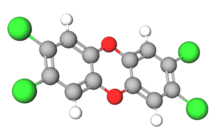
| |

| |

| |
| Names | |
|---|---|
| Preferred IUPAC name
2,3,7,8-Tetrachlorooxanthrene | |
| Other names
2,3,7,8-Tetrachlorodibenzo[b,e][1,4]dioxine
Tetradioxin Tetrachlorodibenzodioxin Tetrachlorodibenzo-p-dioxin | |
| Identifiers | |
3D model (JSmol)
|
|
| Abbreviations | TCDD; TCDBD |
| ChEBI | |
| ChEMBL | |
| ChemSpider | |
| ECHA InfoCard | 100.015.566 |
| KEGG | |
PubChem CID
|
|
| UNII | |
CompTox Dashboard (EPA)
|
|
| |
| |
| Properties | |
| C12H4Cl4O2 | |
| Molar mass | 321.96 g·mol−1 |
| Appearance | Colorless to white crystalline solid[1] |
| Density | 1.8 g/cm3 |
| Melting point | 305 °C (581 °F; 578 K) |
| 0.2 μg/L[2] | |
| log P | 6.8 |
| Vapor pressure | 1.5 × 10−9 mmHg |
| Hazards | |
| Occupational safety and health (OHS/OSH): | |
Main hazards
|
Potent carcinogen and persistent organic pollutant.[1] |
| GHS labelling: | |
   
| |
| Danger | |
| H225, H304, H315, H336, H361, H373, H401, H410 | |
| P201, P202, P210, P233, P240, P241, P242, P243, P260, P264, P271, P273, P280, P301+P310, P303+P361+P353, P304+P340+P312, P308+P313, P331, P332+P313, P362+P364, P370+P378, P391, P403+P233, P403+P235, P405, P501 | |
| NFPA 704 (fire diamond) | |
| Flash point | 164.2 °C (327.6 °F; 437.3 K) |
| NIOSH (US health exposure limits): | |
PEL (Permissible)
|
none[1] |
REL (Recommended)
|
Ca[1] |
IDLH (Immediate danger)
|
N.D.[1] |
| Safety data sheet (SDS) | MSDS |
Except where otherwise noted, data are given for materials in their standard state (at 25 °C [77 °F], 100 kPa).
| |
2,3,7,8-Tetrachlorodibenzo-p-dioxin (TCDD) is a polychlorinated dibenzo-p-dioxin (sometimes shortened, though inaccurately, to simply 'dioxin')[3] with the chemical formula C12H4Cl4O2. Pure TCDD is a colorless solid with no distinguishable odor at room temperature. It is usually formed as an unwanted product in burning processes of organic materials or as a side product in organic synthesis.
TCDD is the most potent compound (congener) of its series (polychlorinated dibenzodioxins, known as PCDDs or simply dioxins) and became known as a contaminant in Agent Orange, an herbicide used in the Vietnam War.[4] TCDD was released into the environment in the Seveso disaster.[5] It is a persistent organic pollutant.
- ^ a b c d e NIOSH Pocket Guide to Chemical Hazards. "#0594". National Institute for Occupational Safety and Health (NIOSH).
- ^ Shiu WY; et al. (1988). "Physical-chemical properties of chlorinated dibenzo-p-dioxins". Environ Sci Technol. 22 (6): 651–658. Bibcode:1988EnST...22..651S. doi:10.1021/es00171a006. S2CID 53459209.
- ^ Tuomisto, Jouko (2019) Dioxins and dioxin-like compounds: toxicity in humans and animals, sources, and behaviour in the environment. WikiJournal of Medicine 6(1): 8 | https://doi.org/10.15347/wjm/2019.008
- ^ Schecter A, Birnbaum L, Ryan JJ, Constable JD (2006). "Dioxins: an overview". Environ. Res. 101 (3): 419–28. Bibcode:2006ER....101..419S. doi:10.1016/j.envres.2005.12.003. PMID 16445906.
- ^ M.H. Sweeney; P. Mocarelli (2000). "Human health effects after exposure to 2,3,7,8- TCDD". Food Addit. Contam. 17 (4): 303–316. doi:10.1080/026520300283379. PMID 10912244. S2CID 11814994.
